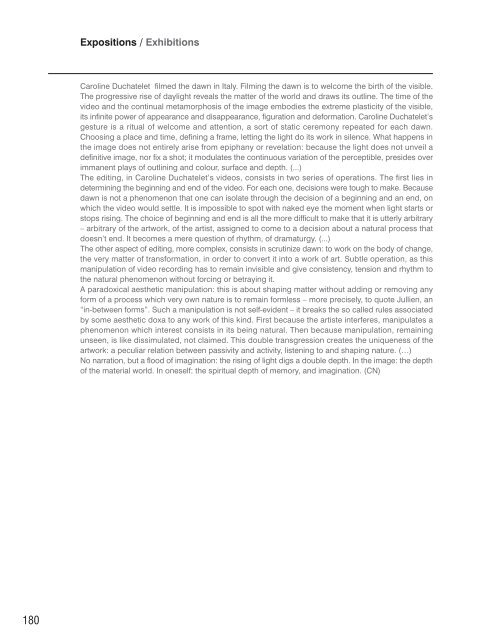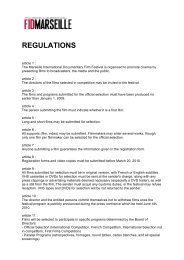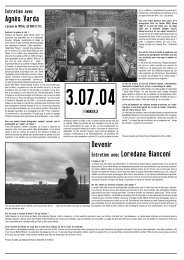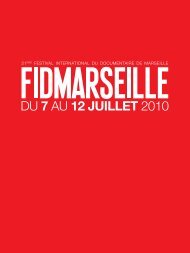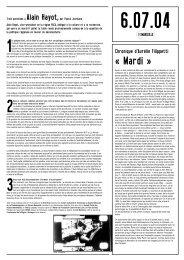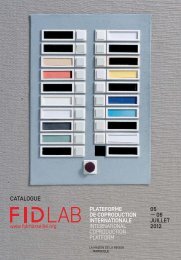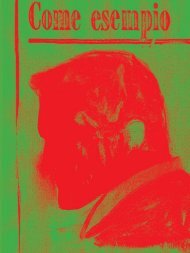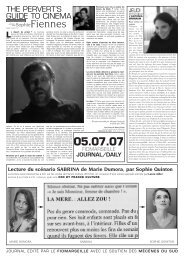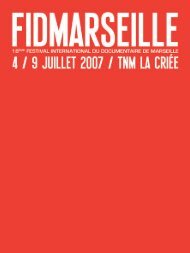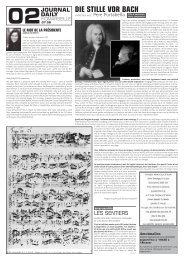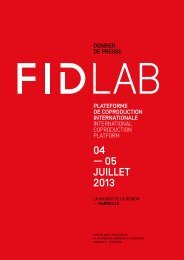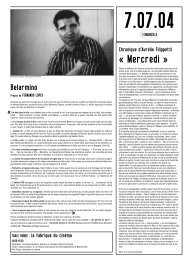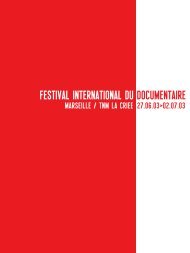FID Marseille 2011 - Festival international du documentaire de ...
FID Marseille 2011 - Festival international du documentaire de ...
FID Marseille 2011 - Festival international du documentaire de ...
Create successful ePaper yourself
Turn your PDF publications into a flip-book with our unique Google optimized e-Paper software.
Expositions / ExhibitionsCaroline Duchatelet filmed the dawn in Italy. Filming the dawn is to welcome the birth of the visible.The progressive rise of daylight reveals the matter of the world and draws its outline. The time of thevi<strong>de</strong>o and the continual metamorphosis of the image embodies the extreme plasticity of the visible,its infinite power of appearance and disappearance, figuration and <strong>de</strong>formation. Caroline Duchatelet’sgesture is a ritual of welcome and attention, a sort of static ceremony repeated for each dawn.Choosing a place and time, <strong>de</strong>fining a frame, letting the light do its work in silence. What happens inthe image does not entirely arise from epiphany or revelation: because the light does not unveil a<strong>de</strong>finitive image, nor fix a shot; it mo<strong>du</strong>lates the continuous variation of the perceptible, presi<strong>de</strong>s overimmanent plays of outlining and colour, surface and <strong>de</strong>pth. (...)The editing, in Caroline Duchatelet’s vi<strong>de</strong>os, consists in two series of operations. The first lies in<strong>de</strong>termining the beginning and end of the vi<strong>de</strong>o. For each one, <strong>de</strong>cisions were tough to make. Becausedawn is not a phenomenon that one can isolate through the <strong>de</strong>cision of a beginning and an end, onwhich the vi<strong>de</strong>o would settle. It is impossible to spot with naked eye the moment when light starts orstops rising. The choice of beginning and end is all the more difficult to make that it is utterly arbitrary– arbitrary of the artwork, of the artist, assigned to come to a <strong>de</strong>cision about a natural process thatdoesn’t end. It becomes a mere question of rhythm, of dramaturgy. (...)The other aspect of editing, more complex, consists in scrutinize dawn: to work on the body of change,the very matter of transformation, in or<strong>de</strong>r to convert it into a work of art. Subtle operation, as thismanipulation of vi<strong>de</strong>o recording has to remain invisible and give consistency, tension and rhythm tothe natural phenomenon without forcing or betraying it.A paradoxical aesthetic manipulation: this is about shaping matter without adding or removing anyform of a process which very own nature is to remain formless – more precisely, to quote Jullien, an“in-between forms”. Such a manipulation is not self-evi<strong>de</strong>nt – it breaks the so called rules associatedby some aesthetic doxa to any work of this kind. First because the artiste interferes, manipulates aphenomenon which interest consists in its being natural. Then because manipulation, remainingunseen, is like dissimulated, not claimed. This double transgression creates the uniqueness of theartwork: a peculiar relation between passivity and activity, listening to and shaping nature. (…)No narration, but a flood of imagination: the rising of light digs a double <strong>de</strong>pth. In the image: the <strong>de</strong>pthof the material world. In oneself: the spiritual <strong>de</strong>pth of memory, and imagination. (CN)180


